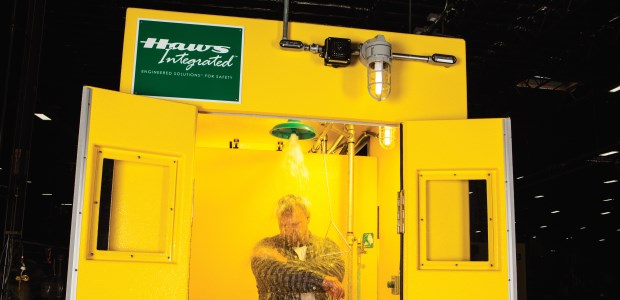
When Overfamiliarity Becomes a Problem
Avoid the dangerous trap in emergency equipment maintenance.
- By Casey Hayes
- Oct 01, 2015
Whether it's the back of your own hand or the drive you take to work five days a week, we become exceptionally familiar with certain things. And even though both of these examples are something you see regularly, you're likely missing the changes that are happening right before your eyes. It makes sense—things such as aging and maturing landscapes take place over a long period of time. You simply become accustomed to what you see day in and day out.
The same familiarity can be true of emergency equipment maintenance. And that's a problem. Changes and deterioration to your emergency equipment can often be hidden from view or take place over a protracted period. In either case, noting a problem likely takes a greater degree of attention. Better yet, it requires an objective, third-party evaluation.
ANSI Z358.1-2014 specifies that emergency showers, eyewashes, and combination units "shall be activated weekly for a period long enough to verify operation and ensure that flushing fluid is available." Among other things, this requirement is designed to assure the operational condition of the equipment hasn't been overlooked. Additional notes in the standard direct us to "ensure that there is a flushing fluid supply at the head of the device and to clear the supply line of any sediment buildup that could prevent fluid from being delivered to the head of the device and to minimize microbial contamination due to sitting water." It's perfectly logical—the mechanical function of activating drench showers and eyewashes weekly must be performed to keep the machine functioning properly.
But what about other aspects of emergency equipment design, installation, and operation? What about mandates such as the 10 second, unimpeded access to emergency showers and/or eyewashes? What about the likelihood of mineral buildup on the spray heads? It's entirely possible that obstacles have inadvertently been placed in the path to emergency equipment and that the spray heads have been impacted by material buildup from the facility or water supply. But the only way to notice such things is by taking the routine maintenance of emergency equipment a few steps further. To that end, weekly status checks should be performed only by people who are paying attention to absolutely everything and using a checklist that ensures all required elements are being properly reviewed.
The Annual Inspection
ANSI Z358.1 also specifies the need for an annual evaluation of emergency equipment. This yearly evaluation is far more thorough and includes areas such as individual shower/eyewash and total system overall operation, possible impacts of multiple simultaneous use of shower and/or eyewash equipment, physical installation of equipment, accessibility versus the standard minimums, establishing whether specific pieces of equipment are obsolete versus current standard requirements, and overall owner/management compliance to the standard.
It's always a good idea to have the annual inspection done by an outside party that is knowledgeable on the specifics of the standard and how it applies to various industrial operations. That objective third party should also have a strong knowledge of the most current emergency equipment design to help evaluate and determine your facility's current state. And who fits this description? Manufacturers and local representatives of emergency equipment manufacturers are uniquely qualified to provide such a service to their customers.
During the annual safety survey, the specific facility, drench shower and eyewash product capability, functionality, victim comfort enhancements, and owner/management responsibilities are reviewed against the most recent standard requirements. A quality survey also includes a pragmatic assessment of the equipment used from a "real world" use perspective. This assessment moves beyond the letter of the law as established by ANSI to consider specific capabilities, such as:
- Actuation: Stems in the actuator ball valves of showers and eyewashes should be constructed of stainless steel. While the standard is not specific enough to require this added feature, stainless steel mitigates the possibility of shearing off the stem when a panicked employee hits the actuator harder than planned. Likewise, pull handles should be easy to see and grasp. Their design is critical, particularly when viewed from the perspective of an injured, possibly vision-impaired and very likely panicked employee. Interestingly, we still see pull chain-type equipment in use even in modern facilities today, despite the incongruity of expecting an injured worker to be able to successfully grab a swinging chain immediately following an accident. While such a feature might seem fine to those who see it every day, it's the kind of thing that would stand out to a third-party reviewer.
- Integral flow controls: Flow control is not a standard requirement, but it ensures that the actual operation of the equipment will be conducive to victims using the equipment for the full 15-minute drench or irrigation protocol and receiving the maximum benefit. Integral flow controls ensure that the pressure and spray pattern are consistent throughout the use cycle. Fluctuations in line pressure can cause surges and starvation, which can minimize diffused flow patterns and negatively impact victim comfort.
- Flooring and drains: A drench shower will use about 300 gallons of water during a compliant 15-minute use cycle. Even though it isn't required, accommodations should be considered for disposing of or dealing with that much water. Drains should be available to handle the wastewater produced during a use cycle and non-slip surfaces should be incorporated into the overall design. Consideration also should be given to proper disposal of wastewater from shower or eyewash use.
While human nature allows us to overlook subtle changes in the things we see every day, precautions should be taken in some instances. The evaluation of emergency preparedness in the workplace is one of them.
This article originally appeared in the October 2015 issue of Occupational Health & Safety.